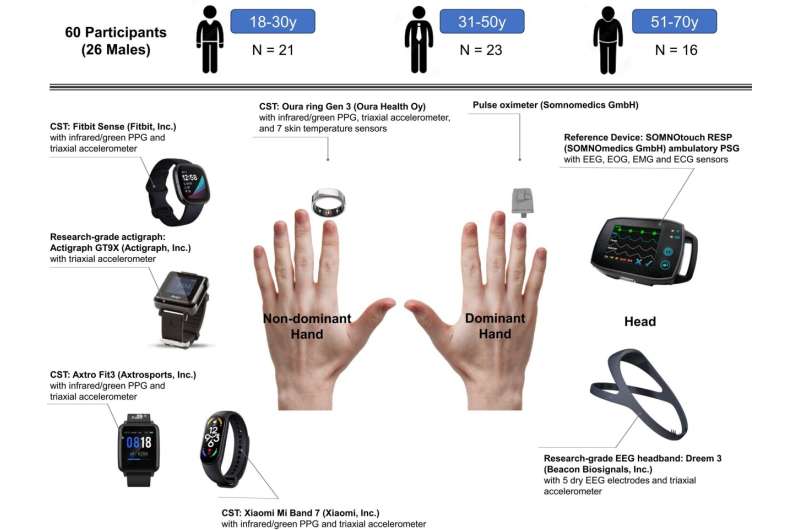This article has been reviewed according to Science X's editorial process and policies. Editors have highlighted the following attributes while ensuring the content's credibility:
fact-checked
trusted source
proofread
Sleep trackers everywhere: How does one choose?

With the growing number and variety of wearable sleep tracking devices in the market today, users are often unsure which one best fits their needs. Commentaries by consumer facing reviewers often look at features that researchers or clinicians treating patients do not. The latter are influential, but because they predominantly face persons with sleep complaints and not those who are mostly healthy, the goals of the latter—to self-understand sleep and maintain or improve it—tend to be submerged by technical concerns that may not be relevant.
Spurred by a desire to provide clear guidance to persons with health improvement in mind, a team of researchers led by Professor Michael Chee, Director of the Center of Sleep and Cognition at the Yong Loo Lin School of Medicine, National University of Singapore (NUS Medicine) and Assistant Professor Ju Lynn Ong from the same Center, evaluated the sleep tracking performance of different categories of wearable devices against a reference system, this time taking a user's perspective in the approach to testing and framing of the findings. The study is published in the journal Sleep Health.
Some 60 participants, evenly spaced between 18 to 70 years old, participated in this study. Each participant concurrently tested six devices. Data from participants who did not sleep well on the first night of testing were retained to emulate the real-life scenario of having a poor night of sleep.
Six devices were compared against polysomnography (PSG), the relatively immobile, expensive, and labor-intensive reference instrument for sleep measurement in clinics and laboratories.
The devices tested fell into four categories. The first was a research-grade electroencephalogram or EEG headband that records brain electrical signals. Such devices approximate the sleep staging performance of a lab PSG. While portable, they cannot be readily purchased over the counter, and a quarter of participants were uncomfortable sleeping with them.
The second category of devices tested was a "research actigraph," which infers sleep only from assessing moment-to-moment fluctuations in limb movement. Many researchers continue to use such instruments, and some maintain that they are better than consumer wearables.
The third category of devices (one wrist-worn, one ring-based) belongs to a class of iteratively-improved, multi-sensor consumer sleep trackers, where both sleep-staging algorithms and hardware refinements have been made over time. Multi-sensor trackers combine information from motion, heart rate and temperature sensors, as well as sensor-free modeling of expected sleep patterns to infer and stage sleep without measuring brain electrical signals.
In theory, such a device should be superior to a "research actigraph" because of having more sensors. Indeed, the well-validated non-EEG wearables showed superior performance. In persons with good sleep efficiency, a majority (80-90%) of nights from such devices were also within the clinically accepted 30-minute bound for common sleep measurements.
However, just adding on sensors and sleep algorithms does not make for a quality device that outperforms "research actigraphy." This was shown in the poor performance, especially for wake detection in the fourth category of low-cost wrist-worn multi-sensor devices, with accuracies of just 33%.
For 4-stage (wake, light, deep vs. REM) classification, the research-grade EEG headband again performed the best. Among other devices, the ring-based wearable Oura came second. The research team felt that with wearables, just focusing on sleep/wake detection is more relevant to most users. Sleep timing, regularity and duration which arise from such data are amenable to improvement by lifestyle changes, while sleep stage durations are not readily modifiable.
The findings underscore the importance of considering user needs when selecting an appropriate sleep tracker. For most users who are relatively healthy, who mostly do not have difficulty initiating or maintaining sleep, but who want to keep tabs on their sleep habits to maintain or improve them, iteratively-improved non-EEG wearables are well suited for this specific purpose.
Consumers should be wary that while many wearable sleep trackers appear to have the same sensors and displays, there are underlying technicalities that clearly distinguish better, reputable devices from the rest.
More information: Ju Lynn Ong et al, Selecting a sleep tracker from EEG-based, iteratively improved, low-cost multisensor, and actigraphy-only devices, Sleep Health (2023). DOI: 10.1016/j.sleh.2023.11.005



















